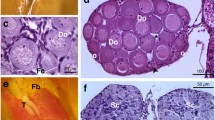Abstract
The causative agents (hormones) involved in amphibian metamorphosis as well as the involved specific endocrine organs have been well established for decades. Tri-iodothyronine and thyroxin, both secretions of the larval thyroid gland, are directly responsible for metamorphosis under physiological conditions. High amounts of the element iodine (approximately 300 times the amount found in equally effective levels of thyroxin) can also induce metamorphosis in amphibians. In a search for an appropriate emulsifier to be employed in studying the effects of hydrophobic polychlorinated biphenyls (PCBs) on metamorphosis, reagent-grade acetone (a commonly used carrier molecule for PCBs) was found to be a potent inducer of metamorphosis inAcris gryllus. The acetone was employed as a component of an artificial pond water (APW) medium. Other test conditions included exposure to thyroxin and dimethyl sulfoxide (DMSO) for comparison. Not only was metamorphosis enhanced in the acetone-treated animals, but the effect was concentration-dependent when acetone levels of 10 mg/L and 50 mg/L were employed. The 50 mg/L acetone-treated group showed precocious metamorphosis at a rate not significantly different from that produced by thyroxin. Dimethyl sulfoxide exposure produced no significant increase in metamorphic rate.
Similar content being viewed by others
References
Abeloos M (1955) Les metamorphosis. Armad Collins, Paris
Adams JA (1983) Effects of PCB (Aroclor®1254) on early development and mortality inArbacia eggs. Water Air Soil Pollut 20:1–5
Adams JA, Haileselassie H (1984) The effects of polychlorinated biphenyls (Aroclor® 1016 and 1254) on mortality, reproduction, and regeneration inHydra oligactis. Arch Environ Contam Toxicol 13:493–499
Adams JA, Lawson WG (1981) Effects of PCB (Aroclor® 1254) on reproduction, behavior, and survival ofHydra viridis. J Tenn Acad Sci 56:119–122
Adler L (1914) Metamorphosestudien andBatrachier larven. Roux Arch 39:21–45
Allen BM (1918) The results of thyroid removal in larvae ofRana pipens. J Exp Zool 24:499–519
—(1929) The influence of thyroid and hypophysis upon growth and development of amphibian larvae. Q Rev Biol 4:325–352
—(1938) The endocrine control of amphibian metamorphosis. Biol Reviews 13:1–19
Cole KD, Little GH (1983) Bile pigments of bilirubin UDP-glucuronyl transferase during the metamorphosis ofRana catesbeiana Tadpoles. Comp Biochem Physiol 76(3):503–506
Collins WT, Capen CC, Kasza L, Carter C, Dailey RE (1977) Effects of polychlorinated biphenyl (PCB) on the thyroid gland of rats. Am J Pathol 89(1):119–130
Dickerson MC (1907) The frog book. Doubleday Page, New York,p 156
Fingerman SW, Fingerman M (1979) Comparison of the effects of fourteen-day and chronic exposures to a polychlorinated biphenyl, Aroclor® 1242, on molting of the fiddler crab,Uca pugilator. Bull Environ Toxicol 21:352–357
Hauser KF, and Gona AG (1984) Purkinje cell maturation in the frog cerebellum during thyroxin-induced metamorphosis. Neuroscience 11(1):139–155
Komives GK (1979) Body weights, food intakes, and water intakes in rats during daily administration of controlled doses of polychlorinated biphenyls. Bull Environ Contam Toxicol 22:761–766
Lehninger AL (1975) Biochemistry, 2nd edn. Worth Publishers, New York, pp 256–257
Loomis WE, Lenhoff HM (1956) Growth and sexual differentiation ofHydra in mass culture. J Exp Zool 132:555–568
Moriya T, Thomas CR, Frieden E (1984) Increase in 3, 3′-tri-iodothyronine (T3)-binding sites in tadpole erythrocyte nuclei during spontaneous and T3-induced metamorphosis. Endocrinology 114(1):170–175
Oerberg J, Kihlstrohm E (1973) Effects of longterm feeding of polychlorinated biphenyls (PCB, Chlophen® A60) on the length of oestrous cycle and on the frequency of implanted ova in the mouse. Environ Res 6:176–179
Schwind J (1933) Tissue specificity at the time of metamorphosis in frog larvae. J Exp Zool 66:1–14
Weiss PA, Willier BH, Hamburger V (1955) Analysis of development. Saunders, Philadelphia, pp 346–401
Wilkin L (1960) The thyroid gland. Sci Am 202(3):119–129
Author information
Authors and Affiliations
Rights and permissions
About this article
Cite this article
Pollard, S., Adams, J.A. Artificially induced metamorphosis acetone inAcris gryllus . Arch. Environ. Contam. Toxicol. 17, 419–428 (1988). https://doi.org/10.1007/BF01055506
Received:
Revised:
Issue Date:
DOI: https://doi.org/10.1007/BF01055506




